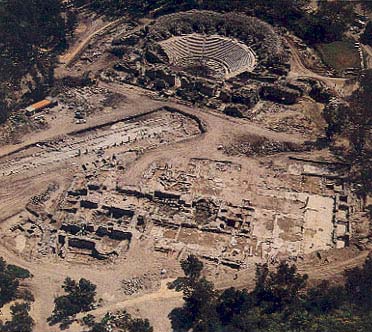Image Details

Richard Nowitz
Beth-Shean’s grand bathhouse (center and lower right). Abutting the colonnaded street (left edge of photo to center) that connected the theater (top center) with the public buildings at the foot of the tell, the bathhouse dates to the Byzantine era. Its sprawling 1.5 acres included several halls, pools, courtyards and a colonnaded portico on three of its sides. Visible in this aerial photo are the hypocausts—tightly spaced column stubs—erected beneath the floor of three hot-rooms. The short columns supported the floor and at the same time allowed steam and hot air from adjacent furnaces to circulate and heat the room above.
The bathhouse continued in use into the Arab period (after 636 A.D.), though for a very different purpose: It was converted into animal pens. Among the discoveries here from that time were the skeleton of a horse and parts of a metal saddle.
